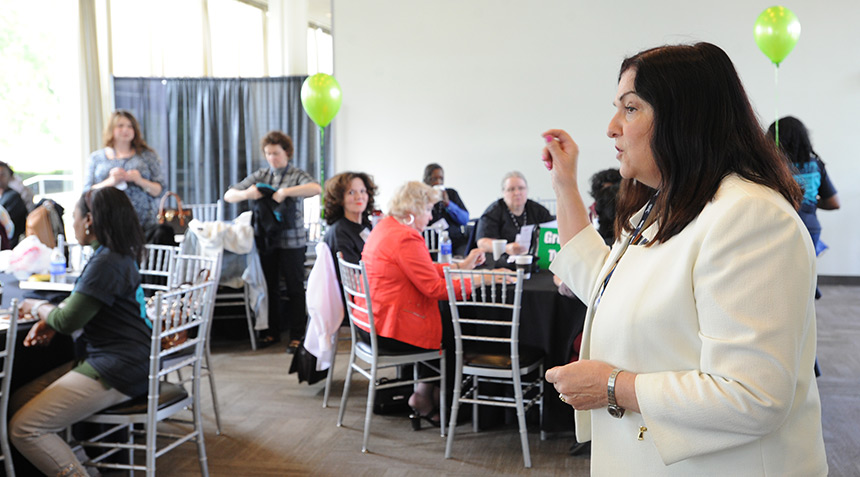According to Nancy Barth-Miller, a New York City hospital nurse and NYSUT nursing leader, it’s not complicated: Adequate nurse staffing is key to quality patient care and nurse retention, and inadequate staffing endangers patients and drives nurses from the profession.
Still, over many years, the state Legislature has ignored the obvious and put hospital profits over patient safety.
“It would be a win-win for them if they would just listen to the people who are doing the work on the front lines,” Barth-Miller told Bronx Assemblyman Michael Benedetto in a meeting on NYSUT’s Health Care Professionals Lobby Day.
The Safe Staffing Ratios for Quality Care Act was the top priority for the day as nurses and other union health care professionals met with legislators to tell stories from their work experience in hospitals, home settings and schools.
“It’s long overdue,” said Anne Goldman, who chairs NYSUT’s Health Care Professionals Council, speaking to hundreds of volunteer lobbyists-for-a-day from several unions gathered at the Empire State Plaza Convention Center in Albany.
“We have been on a journey that is undeniably essential for each of you to correctly and safely do the work we are so proud of for every patient you serve,” she said. “This is the year we are going to do it!”

Anne Goldman, who chairs NYSUT’s Health Care Professionals Council, preps volunteers for the day of advocacy. Photo by El-Wise Noisette.
The bipartisan bill — with nearly 100 co-sponsors in the Assembly and nearly 30 in the Senate — would save lives by ensuring an adequate number of nurses at the bedside of patients in New York hospitals. It would establish safe nurse-to-patient ratios at all New York hospitals; require hospitals to staff units using nurses trained for that unit; require hospitals to be more transparent about their staffing levels; and set a maximum number of patients per nurse.
The grassroots activists also pushed lawmakers to support a bill to ban mandatory overtime for home care nurses. In 2008, the state banned mandated OT in hospitals and other health care institutions, but that law does not restrict the number of hours a home care nurse can be required to work. Visiting nurses can still be forced to work overtime with little or no warning. With a shortage of nurses, it happens more and more often these days.
Jacqueline Cato-Lee of the Visiting Nurse Service of New York recalled a time when her daughter, who goes to college in another state, had been injured. Cato-Lee was planning to drive to her daughter’s school after work and take care of her. But, when the end of the day came, her manager told her she had to take on another shift.
“Home care is not like hospital care; in a hospital, you have back up,” she said. “My work-life balance was challenged, I was tired, I was distracted. As a result, I could have made a mistake that could have harmed a patient,” she said.
But there was nothing she could do. Nurses — in the home care setting — who refuse or decline the mandatory overtime can be charged with abandoning a patient or patients. That’s a serious charge.
“After the attack on 9/11, these nurses were the first ones to say, ‘I’ll go down there!’” said Angela Kuhn of the Federation of Nurses-UFT. “They would never abandon a patient.”
The third bill advocated by NYSUT’s health care warriors would mandate a school nurse in every school building for the Big 5 city school districts. It also would require these districts to consult with at least one professional nursing association to determine if they need more than one nurse per building.
Students in large city school districts deserve the same level of on-site medical care as students in other districts, Goldman said. By requiring at least one nurse on staff at each building, “the state will move closer toward ensuring the health and well-being of all students in the public schools,” she said.